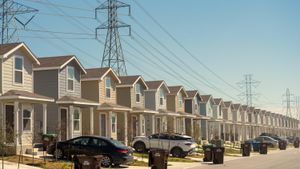A groundbreaking development has emerged as London witnesses the activation of its newest electricity tunnel, marking a significant step toward modernizing the city’s energy infrastructure. The high-voltage network connecting the Hurst substation in Bexley to Crayford has been energized, bolstering the electricity supply for numerous households across the capital.
The previous cables, which had served the area for over five decades, were nearing the end of their operational lifespan, prompting this substantial upgrade. According to National Grid, the newly implemented infrastructure is part of a larger initiative aimed at constructing more than 18 miles (approximately 29 kilometers) of tunnels beneath London, ensuring the city’s electricity supply remains secure and reliable for years to come.
Alice Delahunty, the president of National Grid Electricity Transmission, expressed her enthusiasm about this progress, stating, "There’s still a way to go on the project, but the Hurst-Crayford circuit seeing volts for the first time is a tremendous achievement for our National Grid teams and supply chain partners. It’s hard to overstate what an engineering challenge it has been to build over 20 miles of tunnels under London to upgrade and futureproof the capital’s electricity supplies, so the project’s progress to date is a real testimony to all those involved."
The ceremonial celebration of this project saw Energy Minister Michael Shanks visiting the New Cross substation to express his commendation. He remarked, "The London Power Tunnels show British infrastructure at its best and I congratulate the efforts of everyone involved, as this new circuit switches on to power up homes and businesses across the capital." This initiative is part of National Grid’s £1 billion London Power Tunnels 2 (LPT2) project, which also includes two more significant undertakings: the 7.4-mile (12 km) tunnel between Wimbledon substation and New Cross and the 11-mile (18 km) tunnel linking New Cross to Hurst.
With the completion of just over 20 miles (approximately 32.5 km) of tunnels, this infrastructure upgrade is intended to alleviate disruptions resulting from maintenance activities typically executed at street level. Presently, most of the electricity supply for South London is transmitted through cables located just beneath the road surface, and this construction aims to modernize the setup for sustainability.
This latest tunneling venture is not without precedence; it follows the successful completion of another extensive project back in 2018, which took seven years and also cost around £1 billion. At the time, the focus was the reconfiguration of electricity networks and the installation of two substations to improve efficiency across North London.
Transitioning from energy infrastructure to technological advancements, the conversation quickly shifts toward the role of quantum computing in enhancing the efficiency of power grids. The growing complexity of electricity demand and the transition to net-zero carbon emissions have necessitated the assistance of high-performance computers. These computers assist operators like National Grid UK to manage grid expansions and optimize the timing of energy production.
Research teams at the University of Oxford, led by experts in quantum computing, recently published findings through Joule, highlighting how this sophisticated technology could play a pivotal role in optimizing the planning and function of power grids as they transition to net-zero. The upcoming years see National Grid planning to invest approximately £30 billion ($38 billion) on enhancing power grid infrastructures.
This large sum will underwrite low-carbon technologies comprising wind, solar, nuclear energy, and batteries. The intent behind such significant investments is also to accommodate the expected surge of electric vehicles (EVs) and heat pumps within local distribution networks. Implementing effective planning will directly influence energy bills for consumers and the frequency of power cuts, making strategic investment all the more critical.
Quantum computing promises to offer solutions to the operational challenges presented by fluctuated energy demands and diverse renewable energy sources. For example, as the demand for energy fluctuates—especially during the evening when many people return home—a coordinated response from the grid must maintain equilibrium between generation and demand to prevent outages. Quantum computers may help by facilitating the scheduling of energy demands across smart homes, which could potentially equate to the total output of large power plants.
While the excitement around quantum computing grows, it’s key to realize its potential benefits are undergoing active research and may take time before mainstream application. Currently, quantum computers are still classified under what’s termed the noisy intermediate-scale quantum (NISQ) era, with expectations of full-fledged, general-use quantum machines remaining at least ten years away. Nevertheless, the benefits of existing quantum computing capabilities have started to be recognized, particularly when it involves solving complex, intertwined decision-making scenarios—essential for planning and managing power supplies.
Additional innovative approaches being examined by National Grid include developing retrofitted insulated cross arms on transmission towers, which may allow the upgrading of existing lines to higher voltage requirements. Another exciting project involves the used vehicle-to-grid (V2G) technology. This approach rethinks how customers might provide excess energy from their EV batteries back to the grid, helping to manage peak load times significantly more effectively.
National Grid's commitment to aspiring for carbon-neutral construction methods showcases its proactive stance. By examining alternative, low-carbon materials, National Grid aims to meet its ambitious sustainability targets by 2026. Innovations explored include advanced concrete solutions, 3D-printing capabilities, and various weather-resistant materials. The alliance between efforts on the network and innovation is anticipated to usher substantial savings and environmental benefits.
These initiatives not only underscore the urgency of adequately addressing idle infrastructure but also reveal the collaborative spirit driving the transition to sustainable energy solutions. Through engaging efforts from various stakeholders, including national bodies, technological partners, and infrastructural developers, the vision for greener, more sustainable energy systems is gradually taking shape.



